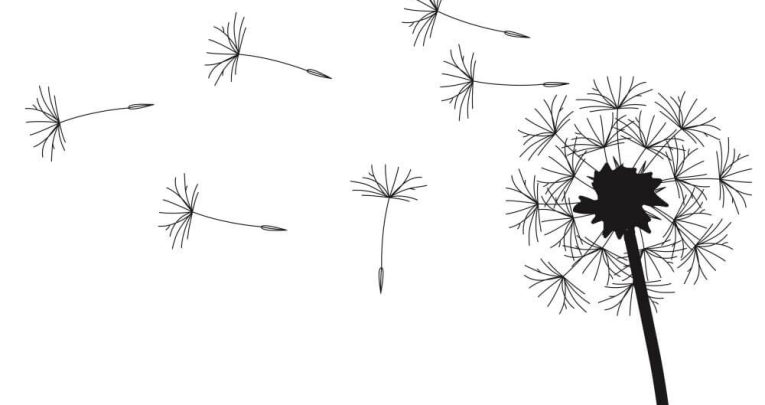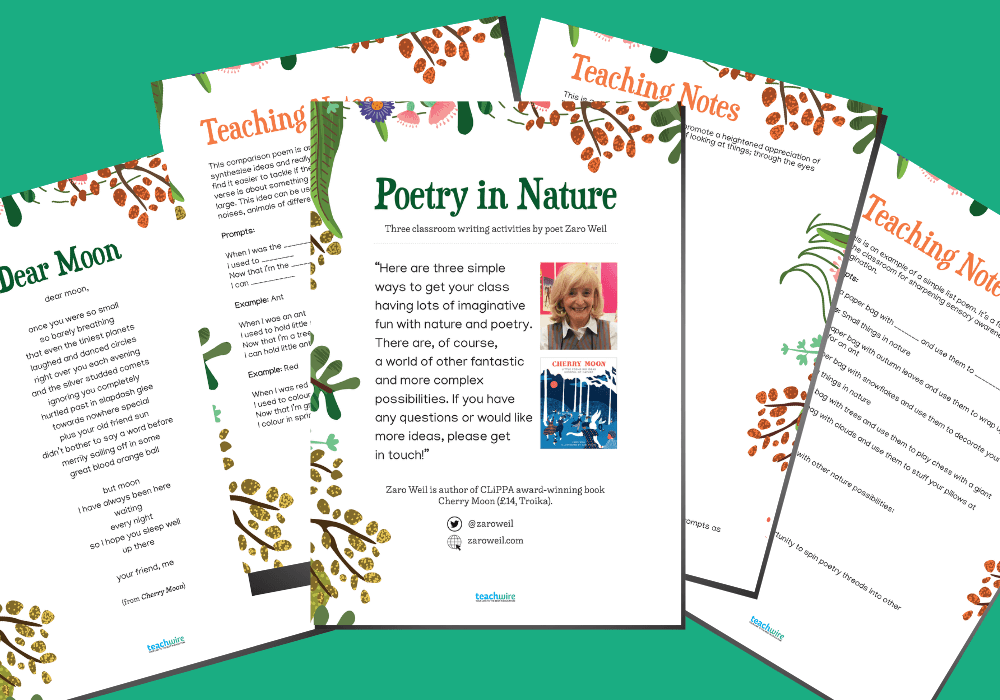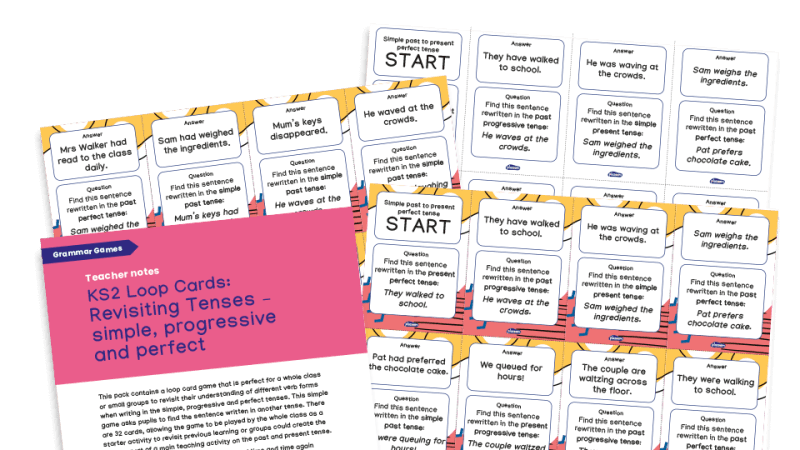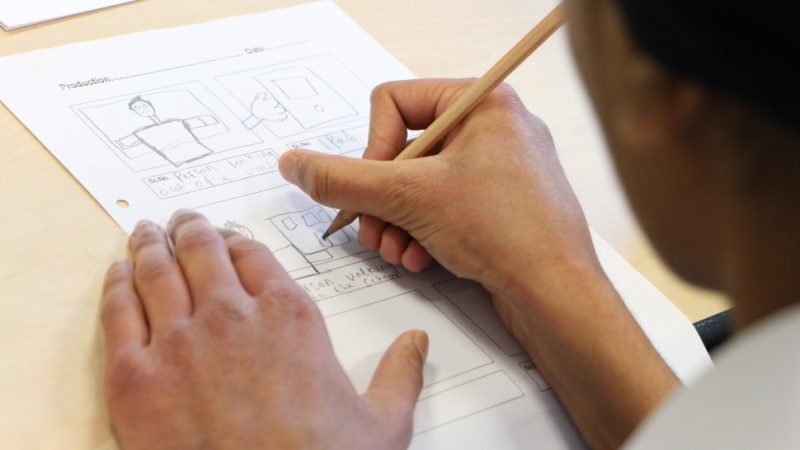Poems KS2 – Explore nature through children’s poetry and creative writing

Poet Zaro Weil on the energising double act of poetry and nature…

- by Zaro Weil

What child doesn’t want to wake up and feel free as the breeze? To go through the day on a whistle and hum?
And to conjure up all the magic, mystery, curiosity and wildness they can at the same time. That’s a happy kid – something we all want for those young children in our charge.
And what is it that creates that whistle and hum? It’s nature: the ever-present universe of creatures, plants and atmosphere here on earth. Pure and simple.
Now, let’s you and I take a walk outdoors. What do we see? Hear? Maybe there is sun. Or wind. A bird flies by. Leaves rustle. Of course, there are many other things going on.
The problem is, most of us don’t always catch the comings and goings of the natural world: the scuttling of bugs; the intricacy of veins on an oak leaf; the shape and colours of ever-shifting clouds; the candied scent of rotting leaves.
Now ask a child when they are outside. It doesn’t matter if they are in a park, on some patch of rough ground in the city or walking through a wild forest. They are in their ‘outdoor’ world. A world of play; of running hard; looking hard; tangling with nature.
Whether nature is a weed popping out of asphalt, a patch of smooth lawn or a leaf-covered woodland floor, it doesn’t matter. For wherever outdoor lies, the child is inordinately serious about it all.
How to write a poem – Magical transformations
KS2 children perceive and experience the world of nature with a closeness, excitement and clarity of vision we adults lack or have forgotten. The child will not just point to a worm wriggling in the ground. He reaches down to get closer; to see it; maybe to pick it up. Nature encourages imagination.
A whipped-up ocean may trigger the possibility of unfettered ideas for sea poems. A beautiful meadow could offer a chance to dream big. The quietness of a dark sky may allow us to feel at ease with our own silence.
For if we look or listen to something long enough and hard enough the object in view magically transforms.
Rocks become figures; shadows grow real; a single leaf rustle can tell a whole story.
Nature looms large with children’s emotions as well. Biting cold wind; gentle snow falling; a hot sun; a swirling river; the glimmer of moonlight on rooftops – these things we experience on the outside can shape inner experience and emotions to a high degree for a child.
How does poetry fit in with this romp in nature? With words, meaning and imagination. Poetry is created through a particular and unexpected musical placement of words which encourage the reader to see and ‘get’ things in a new – almost tickling – way.
Just imagine for a moment the adult ‘you’ steps outside and sees a dandelion. Most of us see, well, a dandelion. “What is that dandelion doing?” someone asks. “It is waving in the breeze,” you might reply. Then ask a child what that dandelion is up to. They might say without blinking twice, “It’s tickling the sky” or “It’s telling the sky a secret.”
This personalisation of the environment is the beginning of metaphor; the first sparks of poetry. How does the fog come? It comes on little cat feet, says Carl Sandburg in his poem Fog.
My point is that a child’s first response to nature is poetic. They endow nature with a special quality. The dandelion is like something else. It is like them because the dandelion sees the sky like a person would. Nature gives children the freedom to see, question and imagine anything they want.
Trees become figures. Those clouds are battling dragons. The wind is telling me a secret. Nature is personal. Things are like something else. And at once we have metaphor, the heart and soul of poetry.
Types of poems – Powerful poems
This world of imagination and poetic play is also the world of language. Stories and poetry are the way information has been shared and passed down through generations. Interaction with language is vital for exercising the imagination. When we hear a powerful poem we visualise it, feel it, even become it a little.
And not only that – we learn to ‘super’ listen; to hear both the words and the silence between them; to see both the trees and the spaces between them. Our experience is enriched until we are magically transformed. And the more exacting and exciting the language, the further and deeper our visions can travel.
William Wordsworth didn’t just see or describe the daffodils dancing outside. He got inside and became them; tangled with them. He danced with daffodils in his poems. He understood nature from the inside out. A child gathers in the world and learns through their senses and through play.
And what better place to harness senses than that great provider, nature? Because when these senses are fed, nurtured and developed they become a storehouse of sense memories; a great learning-pad and enabler of understanding, perception and problem-solving.
Children are poised at the beginning of a long quest for definition and self-identity. And what better way to fill in the mystery of who you are on the inside than by looking at and becoming part of the mystery that is nature, outside.
Not only does poetry allow us to be who we are, it gives us the opportunity to be many of the things we cannot imagine ourselves to be. Listening to, writing or sharing a poem, hearing and feeling the swing and sway of the words, seeing them in our mind’s eye, grips us. It’s a magical, evocative, interactive learning process. As educators, parents, and poets, our challenge is to keep young minds not just listening but involved, curious and open. And what finer way to enable our kids to live and learn free as a breeze with a whistle and hum than through that wonderful energising double act of nature and poetry?
Browse ideas and resources for teaching KS2 poems.










